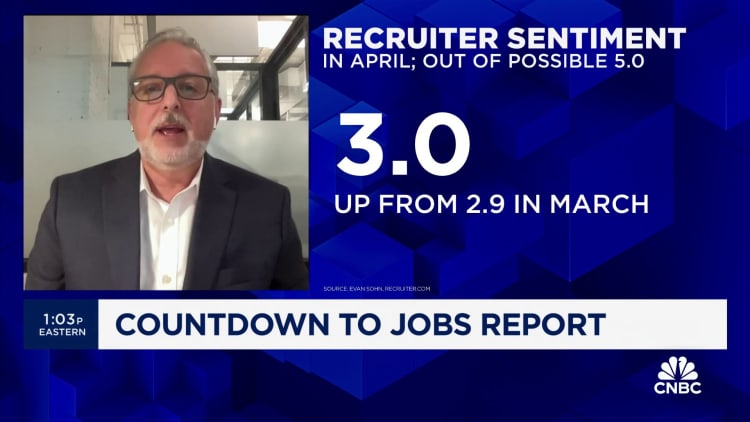[ad_1]
A jobseeker takes a leaflet at a work fair at Brunswick Area University in Bolivia, North Carolina, on April 11, 2024.
Allison Joyce|Bloomberg|Getty Images
Hiring most likely proceeded at a vigorous speed in April as financiers try to find any kind of fractures in the labor market that can guide the Federal Book.
Nonfarm pay-rolls are anticipated to reveal a gain of 240,000 for the month, according to the Dow Jones agreement that additionally sees the joblessness price holding consistent at 3.8%.
If that top-line number is precise, it really would mirror a little go back from the ordinary 276,000 tasks a month produced thus far in 2024. Furthermore, such development can include in the Fed’s hesitation to reduced rates of interest, with the labor market humming along and rising cost of living still over the reserve bank’s 2% target.
” There are certainly still tailwinds left,” stated Amy Glaser, elderly vice head of state of company procedures at work staffing website Adecco. “For April, nitty-gritty is steady-Eddie as resiliency proceeds, and afterwards we’re expecting several of the seasonal fads we would certainly anticipate entering into the summer season.”
April’s tasks market included a lot more stamina in healthcare and recreation and friendliness, Glaser included. Those have actually been 2 of the significant industries for work development this year, with health care adding concerning 240,000 tasks thus far and leisure and hospitality contributing 89,000 tasks.
Nevertheless, development in the coming months can infect locations such as education and learning, production and warehousing, component of the common seasonal fads as teachers try to find different work in the summer season and trainees go out looking for tasks, she stated.
” I do not anticipate to see significant shocks this month based upon what I’m seeing on the ground,” Glaser stated. “However we have actually been stunned prior to.”
Beating expectations
Indeed, the labor market has actually contained shocks this year, covering Wall surface Road approximates each time when lots of financial experts anticipated employing to have actually reduced. The 303,000 gain in March shattered forecasts and were part of a glut of data showing that the labor economy remains strong, wages continue to rise and inflation has not moved much after receding sharply in 2023.
That has pushed the Fed into a box as officials are reluctant to start cutting interest rates until they get more convincing evidence that inflation is under control.
Policymakers will be watching several pieces in tomorrow’s report for evidence that job growth is not helping fuel price pressures.

If the payrolls growth misses expectations by a little and wage pressures diminish while more people enter the labor force, that would be an ideal scenario for the Fed, said Drew Matus, chief market strategist at MetLife Investment Management.
“The Goldilocks scenario is an unemployment rate rise with a participation rate rise,” Matus said. “What that’s suggesting is there’s a little bit of weakness that should translate into less wage pressure and take some of the concerns about sustained sticky high levels of inflation off the table.”
Investors on the lookout
Markets also will be watching the wage numbers closely.
Consensus estimates put average hourly earnings growth at 0.3% on the month, near the March move, and the yearly increase at 4%, or just below the 4.1% the month before. However, Matus said the wage numbers could be distorted by immigration patterns as well as California’s minimum wage increase this year to $16 an hour.
“Inflation has eased substantially over the past year, while the labor market has remained strong, and that’s very good news,” he said at his news conference after the central bank’s latest meeting. “But inflation is still too high.”
Markets have been in a state of flux as uncertainty over the Fed’s rate path has grown, though Wall Street was in rally mode Thursday, the day before the Bureau of Labor Statistics report drops at 8:30 a.m. ET.
“What you’re seeing in markets reflects the uncertainty around the path forward. What’s going to be more important to the Fed, unemployment or inflation?” Matus said. “If unemployment starts moving higher, is the Fed going to care as much about inflation as they do today? Or vice versa? And I don’t think even with all the information the Fed’s given us, that we know. I don’t think anyone knows and I think that’s why you’re seeing the market behave the way it is.”

[ad_2]
Source link




